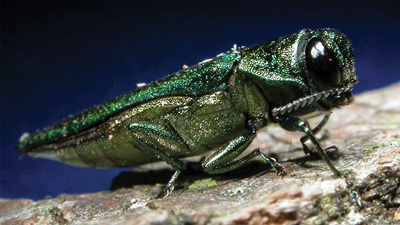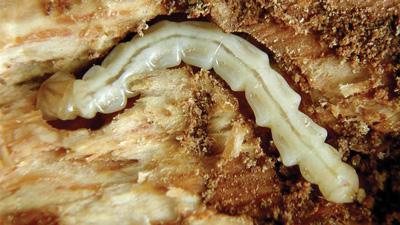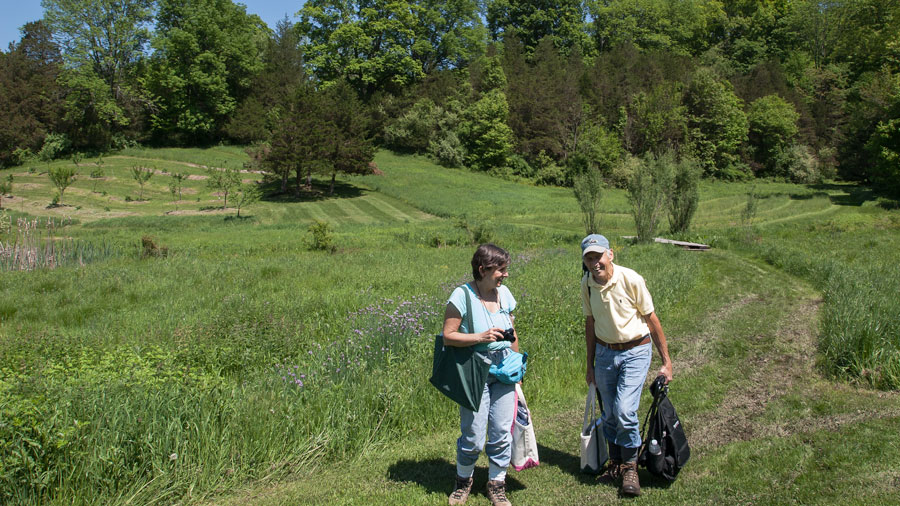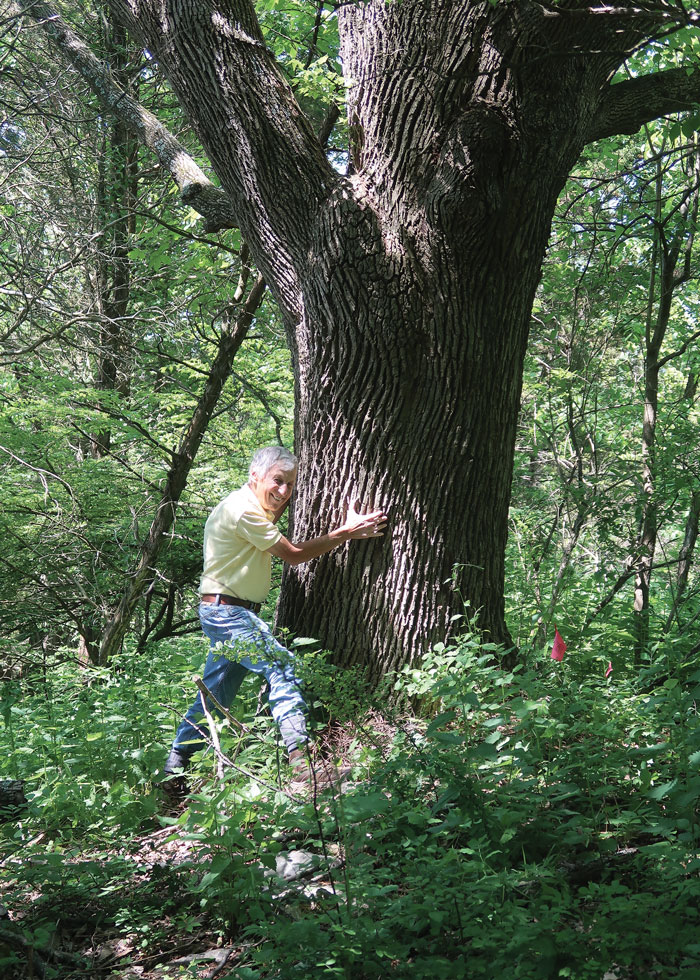
There’s a tree that I look at nearly every day. It’s a huge ash tree that towers above our house just outside my bedroom window. Its trunk is close to three feet in diameter at the base and extends up more than fifty feet before it reaches the first group of branches. From there, the canopy extends up and out another thirty to forty feet in all directions. It is a magnificent looking tree that has been providing shade to our home for nearly forty years. It’s also one of the focal points of a rock garden I’ve been tending for years, with its trunk illuminated at night as part of our garden lighting. I love this tree, so it’s almost unimaginable to think that I might lose it. But that’s a distinct possibility now that the Emerald Ash Borer (EAB) has arrived in New Jersey.
Ash trees can grow over 120 feet high and seventy feet wide and have been known to live three hundred years. As part of the olive family, the trees produce oil similar to olive oil that historically was heated and used to treat stomach pain. Norse mythology holds a special place for the ash tree, and according to Viking legend, the mythological god Oden created the first man from an ash tree. It was known as the tree of the world that touches Hell with roots and Heaven with its crown. Prized for its strength and elasticity, more recently the ash has been used to manufacture hockey sticks, canoe paddles, tool handles, hardwood floors and many other items including the famous “Louisville Slugger” baseball bat. Ash is also a popular choice in the fashioning of guitars including the Fender Bass and Stratocaster.
With ash trees being so plentiful in New Jersey, we might witness a momentous transformation to our landscape in the next few years. Ash trees have been planted in our cities and towns to beautify streets, walkways, parks and back yards. Millions more grow wild along country roads, lining our rivers and streams and throughout our national and state parks. Nearly all fifty million ash trees in the state face the same fate. First the leaves will curl, then a branch or two will die, followed by a few more the next year, and within a two-to-four year period the tree will completely die.


The Emerald Ash Borer is a beetle, about the size of a penny that flies from tree to tree depositing its eggs near the top of the tree allowing the larvae to borrow through the bark and feed on the wood. This feeding damages the inner vascular system of the tree, cutting off the flow of water and nutrients. They feed from the top down and slowly kill the tree as they progress. Since all this activity takes place near the treetops, by the time any damage is noticeable, it is often too late to save the tree.
The EAB is native to China and other Asian countries, but I’ve read that ash trees there are largely protected by natural predators. There are too few predators in the US to make much of a difference, and as a result it is able to spread, unimpeded, flying from tree to tree or traveling much further through the transport of firewood, nursery trees and lumber. I first learned about the EAB when it had killed millions of ash trees in the state of Michigan, where it is believed that EAB arrived in the US in 2002, via wood packing material in Detroit. It has taken more than a decade for the EAB to travel across Ohio and Pennsylvania to New Jersey, destroying millions of ash trees along the way. Just as in other states, New Jersey authorities predict that over 99% of all ash trees in the state will be lost. I would miss the ash tree, especially in September when the green leaves quickly turn to gold and then brown before falling to the ground by end of the month, before many leaves of other trees have even begun to change.
I’m considering hiring a professional service to perform a trunk injection on our shade tree, where holes are drilled through the bark into the wood to carry a systemic insecticide to all areas of the tree through its vascular system. It’s a time consuming and reasonably expensive process, but it is reportedly 90% effective. There are three other ash trees on my property that I am hoping to save as well. I’ve learned that since they are all less than twenty inches in diameter, effective results can be obtained through basal trunk spraying directly on the tree, from the base up to about six feet high. Another possibility for the do-it-yourself homeowner is soil drenching, which is simply pouring insecticide directly into the ground over the root system of the tree. Professionals may also recommend foliage spraying, but this method is rarely used due to the potential for drift, harming other insects including bees.
I suspect that applying insecticide is just a band-aid. But it’s that last part — the one about harming other insects — that gives me pause. For most of the last century, chemicals have been the go-to solution for many of the agricultural challenges we have faced. And many of those have ended up causing more problems and imbalances within our increasingly fragile ecosystem. When a friend of mine told me about the Tree Whisperer and invited me to go with him to see what this man was all about, I decided to come along.
Dr. Jim Conroy, the Tree Whisperer, arrived at some conclusions in 2002 (coincidently the same year that the Ash Borer arrived in the United States). After earning his doctorate in Plant Pathology and working for decades as a top executive in the plant health industry, he decided that he and his colleagues in science and marketing were missing something. Walking through fields of crops and forests, he knew that when plants and trees were stressed, their normal functions and processes were compromised. But, even with all the industry’s tools and products, there was nothing to repair the inner processes of plants. External products addressed only the symptoms, rather than heal in concert with changing environment. All anyone could do was watch and hope that the trees and plants would “grow through” their weaknesses.
Holistic schemes for human healing seemed an excellent protocol; the idea that all natural processes that support life need to function at optimal level in their intended alignment. All aspects of our being — physical, mental and spiritual — are best treated together, or as one, to achieve their proper alignment in a healthy balance. Systems were popular in the modern world that combined advanced yoga, meditation, the energy dynamics of acupuncture, the clinical findings of applied kinesiology, diet, and Western medical expertise. Could a holistic approach be applied to plant health, or even an entire ecosystem? With his combination of strong scientific background, extraordinary intuition, and willingness to think out-of-the-box, Dr. Conroy began to develop his holistic system for healing trees and plants — a set of perceptive communication skills with the “inner processes” of plants, those that relate to an innate intelligence, the same that exists in all living things.
We visit Dr. Jim and his partner, Basia Alexander, Conroy’s “chief listener” who illustrates and writes about Jim’s conceptual systems, at a nearby farm where they come regularly to do research and to apply their knowledge to real-world conflicts, most immediate the looming arrival of the Emerald Ash Borer in Warren County. As we start up a hill towards two magnificent ash trees near the edge of the woods, I ask how old the larger one might be. Jim replies, “I’m not sure; maybe about 200 years.” When we get to the hilltop we walk a few feet to the massive base of the splendid ash and begin, as Jim and Basia do with most of their clients, with a meditation.

Facing the ash with my hands flat against its surface, I listen as Basia suggests a connection with our hearts to this living being’s bio-energy. Focusing entirely on it, imagine the power of being the tree, with roots deep in the earth, rising high in the sky looking over everything else, the sun in our face, the breeze in our hair, rainwater soaking up through our bodies. Basia asks us to visualize, as a child might in an unspoiled way, that the tree stands in the middle of an immense chamber joined by countless other beings — trees, plants, bugs, birds, insects, reptiles, fungi, fish, rocks, soil, people — swirling and whirling around the room, conversing with each other. In one corner there is a disagreement among a tree, an insect and a human. You explain that you will open your heart to understand each point of view and help them to find a way to live together in dynamic balance, peace and cooperation. They discuss how they can mutually coexist, finally agree, and explain their agreement to you.
Fifteen minutes later we’re back, and Basia says that this was particularly special, that it was clear to her how the beings interacted in the room, clearly a metaphor for the entire ecosystem. Jim explains how the conflicting parties would not automatically become instant friends, but they worked things out on their own. He adds that the ash told him that it was 173 years old.
I’m not sure how far I got along in visualizing swirling and whirling beings of nature dancing and singing in a gigantic room filled with white light. But there was something to it. I can say I came to appreciate the enormous complexity of this tiny segment of the ash tree’s body in front of me, its bark intricately furrowed with colonies of tiny lichen perched within its creases. I’ve spent countless hours in the company of trees such as this, either working beneath their branches or walking among them through forests. But I don’t remember facing a tree and touching it for any length of time. It’s a little different. I felt a measure of the tree’s incredible strength, of its hold on the earth, and of its part in the living community surrounding us in the woods.
Jim talks more about his work, trying to translate the profound things that he hears/feels/sees into plainspoken perceptions that I might understand. “We look at ecosystems like this that are disconnected, because of the turmoil in the environment, climate change, chemicals, and poisons. An invasive comes in looks like a bully, everybody is doing their own thing and nobody’s connected. People believe that the insect comes and weakens the trees. It’s the other way around, a tree gets weak and the insect comes in. What we do is get everybody connected again and do a special arrangement between these two guys, we work with them to give them a way to coexist, that’s the basis of the work.”
How does Dr. Jim connect? “By working with their consciousness reconnected with our consciousness and bioenergy,” is a distilled version of our two-hour talk that afternoon. “All beings in nature (trees) sing to each other. In the tree’s world one trunk is not a tree, many trunks sing to each other. A trunk sings for help, the insect hears it and heads for the tree. We believe that killing ecosystem members is obsolete, so we help the immigrants get settled and find what they need. We mediate an agreement that we call an EcoPeace Treaty. Once we get them connected, they say how they want to work together. My only role is a go-between when I ask how can they work together. Sometimes there’s so much chatter in the background that I can’t understand, but I usually get an answer by the end of the conversation.”

I have worked for years as a professional landscaper, relying in part on fertilizers and pesticides for quick results in creating idyllic settings for my customers. But the reason I chose to involve myself with trees and gardens is the peace that I found; a feeling that comes from a spiritual connection. If I put aside our culture’s usual assumptions about our place in the natural scheme of things, I really have no reason to believe that Dr. Jim cannot do what he says. His vast empirical skills and experience enable him to see what’s going in a piece of land as soon as he gets in the driveway. In every case he employs his expertise in the biology of plant pathology. The stretch is in the development of his intuitive perception; his ability to connect. An even greater leap is Conroy’s approach to “disease” organisms or insects. Instead of trying to eradicate them, he facilitates ways that they can live in dynamic balance with their “hosts”. When he tells me that I, or anyone, can learn to do it, I listen. It must be his bio-energy; he is very easy to like. “There’s an aspect of memory in our pituitary gland that has been neglected. At a cellular level we have the same memory. You are activating what’s there. Current Western culture’s overriding emphasis on only physical reality has robbed many people of their natural perceptive skills.”
After years of intense research and development of their Green Centrics© system, Jim and Basia have helped many people who have been open to their paradigm; and who agree to respect the living being that is the so-called problem, not to use chemicals, and not to cut down trees. They have increased yields in cabbage crops and fruit orchards without the application of any physical “product”. They have worked successfully with the pine bark beetle in Colorado, and forests stressed by fires in California. They have solved problems for numerous homeowners worried about their beloved trees, rose gardens, or ponds overtaken by algae. Others testify to the protection that Tree Whispers provided during Hurricane Sandy. Right here on this farm, the vegetable gardens are unfenced, and untouched by the deer that live nearby and who have agreed to respect boundaries marked only by small green flags stuck in the ground.
In 2012, Dr. Jim began research regarding the Emerald Ash Borer at sites in New York, Massachusetts and Connecticut, noticing a pattern of spotty appearances near urban and suburban centers, rather than a slow steady progression. He began to treat groves of ash trees in Red Hook, New York, and at the Omega Institute for Holistic Studies in Rhinebeck, where he also teaches. “We’re right in the middle of an invaded region, but they stay out of my area,” Conroy reports. “We got started before the EAB came across the Hudson River. They (the trees) knew it was coming.”
It will require some work for me to truly comprehend Jim and Basia’s view of the universe and the idea of a cooperative EcoPeace Treaty. But in this era of grave ecological challenges — from the imbalances reflected in our own backyards to the apocalyptic implications of climate change, I think that the Tree Whisperer offers a choice whose time may have come. He’s right around the corner, and I’ll listen closely.
For more information about Dr. Conroy, please refer to his website.
For information about the ash borer: www.emeraldashborer.info
About the ash borer in New Jersey: www.nj.gov/agriculture/divisions/pi/prog/emeraldashborer.html